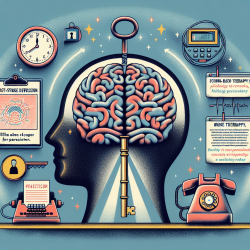Introduction
Post-Stroke Depression (PSD) is a common yet often overlooked condition that affects many stroke survivors. With a prevalence rate of 20 to 60 percent, PSD can significantly hinder recovery, reduce quality of life, and even increase mortality rates if not addressed promptly. As a practitioner, understanding the pathophysiology and current treatment options for PSD is crucial in providing effective care and improving patient outcomes.
Understanding the Pathophysiology of PSD
Despite extensive research, the exact pathophysiology of PSD remains complex and not fully understood. It involves several mechanisms, including dysfunctions in monoamine and glutamatergic systems, the gut-brain axis, and neuroinflammation. These mechanisms contribute to the depressive symptoms observed in stroke survivors, such as depressed mood, loss of interest, and cognitive impairments.
Current Treatment Approaches
Current treatments for PSD include both pharmacological and non-pharmacological approaches. Pharmacological treatments primarily focus on antidepressants, such as Selective Serotonin Reuptake Inhibitors (SSRIs) and Serotonin-Norepinephrine Reuptake Inhibitors (SNRIs), which aim to correct neurotransmitter imbalances. However, these treatments are only effective in 30-40 percent of cases.
Non-pharmacological treatments, such as cognitive-behavioral therapy and physical rehabilitation, play a vital role in managing PSD. These therapies focus on improving mood, enhancing cognitive function, and promoting overall well-being.
Implementing Research Outcomes
Practitioners can improve their skills by implementing the outcomes of recent research on PSD. This includes staying informed about the latest advancements in pharmacological treatments, such as the development of new antidepressants targeting glutamatergic dysfunctions. Additionally, practitioners should consider incorporating non-pharmacological interventions into their treatment plans to provide a holistic approach to PSD management.
Encouraging Further Research
While significant progress has been made in understanding and treating PSD, there is still much to learn. Practitioners are encouraged to engage in further research to uncover new treatment modalities and improve existing ones. Collaborating with researchers and participating in clinical trials can provide valuable insights and contribute to the advancement of PSD care.
Conclusion
Post-Stroke Depression is a challenging condition that requires a comprehensive and informed approach to treatment. By understanding the pathophysiology, staying updated on current treatments, and encouraging further research, practitioners can significantly enhance the care provided to stroke survivors. For those interested in delving deeper into the topic, the original research paper titled Pathophysiology and Current Drug Treatments for Post-Stroke Depression: A Review offers a wealth of information.










